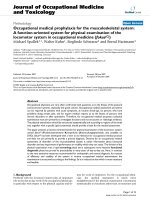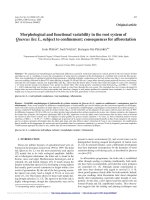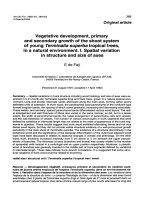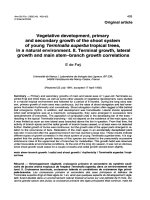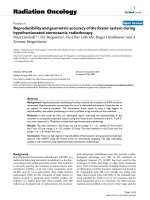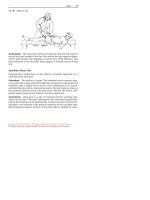Ebook Medical english clear and simple: Part 1
Bạn đang xem bản rút gọn của tài liệu. Xem và tải ngay bản đầy đủ của tài liệu tại đây (6.46 MB, 166 trang )
2165_FM_i-xxiv.qxd
12/2/09
10:52 AM
Page ii
2165_FM_i-xxiv.qxd
12/2/09
10:52 AM
Page i
Medical English
Clear and Simple
A Practice-Based Approach
to English for ESL
Healthcare Professionals
2165_FM_i-xxiv.qxd
12/2/09
10:52 AM
Page ii
2165_FM_i-xxiv.qxd
12/2/09
10:52 AM
Page iii
Medical English
Clear and Simple
A Practice-Based Approach
to English for ESL
Healthcare Professionals
Melodie Hull, RPN, MSc, MEd (TESOL), BA, PID
Nursing Faculty
College of the Rockies
Cranbrook, British Columbia, Canada
Nursing Tutor, Distance Education, Transitions to Nursing and Health Program
Thompson Rivers University
Kamloops, British Columbia, Canada
International Adviser to the Department of Languages
International University of Business, Agriculture, and Technology
Dhaka, Bangladesh
Nurse-Educator and Consultant
Clayton International Consulting
Cranbrook, BC, Canada
2165_FM_i-xxiv.qxd
12/2/09
10:52 AM
Page iv
F.A. Davis Company
1915 Arch Street
Philadelphia, PA 19103
Copyright © 2010 by F.A. Davis Company
Copyright © 2010 by F.A. Davis Company. All rights reserved. This book is protected by copyright. No part of it may be reproduced, stored in a retrieval system, or transmitted in any form or by any means, electronic, mechanical, photocopying, recording, or otherwise, without written permission from the publisher.
Printed in the United States of America
Last digit indicates print number: 10 9 8 7 6 5 4 3 2 1
Acquisitions Editor: Jonathan Joyce
Director of Content Development: Darlene D. Pedersen
Senior Project Editor: Padraic J. Maroney
Design and Illustrations Manager: Carolyn O’Brien
As new scientific information becomes available through basic and clinical research, recommended treatments and drug therapies
undergo changes. The author(s) and publisher have done everything possible to make this book accurate, up to date, and
in accord with accepted standards at the time of publication. The author(s), editors, and publisher are not responsible for errors or
omissions or for consequences from application of the book, and make no warranty, expressed or implied, in regard to the contents of the book. Any practice described in this book should be applied by the reader in accordance with professional standards
of care used in regard to the unique circumstances that may apply in each situation. The reader is advised always to check product information (package inserts) for changes and new information regarding dose and contraindications before administering any
drug. Caution is especially urged when using new or infrequently ordered drugs.
Library of Congress Cataloging-in-Publication Data
Hull, Melodie.
Medical English clear and simple: a practice based approach to English for ESL healthcare professionals/Melodie Hull.
p.; cm.
Includes bibliographical references and index.
ISBN 978-0-8036-2165-7 (alk. paper)
1. Readers—Medicine. 2. English language—Conversation and phrase books (for medical personnel)
3. English language—Textbooks for foreign speakers. 4. Medical personnel, Foreign—United States. I. Title.
[DNLM: 1. Terminology as Topic—Problems and Exercises. 2. Communication—Problems and Exercises.
3. Language—Problems and Exercises. W 18.2 H913m 2010]
PE1127. M4H85 2010
428.6'402461—dc22
2009042818
Authorization to photocopy items for internal or personal use, or the internal or personal use of specific clients, is granted
by F.A. Davis Company for users registered with the Copyright Clearance Center (CCC) Transactional Reporting Service, provided that the fee of $.25 per copy is paid directly to CCC, 222 Rosewood Drive, Danvers, MA 01923. For those organizations
that have been granted a photocopy license by CCC, a separate system of payment has been arranged. The fee code for users
of the Transactional Reporting Service is: 8036-2165-7/10 0 + $.25.
2165_FM_i-xxiv.qxd
12/2/09
10:52 AM
Page v
This book is dedicated to two very important and influential
people in my life:
My very good friend, Patty Sangri, of the Universidad
Tecnologica de Cancun, who gave me my first job in English for
Specific Purposes and who opened
this whole new world to me.
My wonderful husband, Steven, whose unwavering love
and faith in me, as well as his incredible patience and support,
has made this book possible.
THANK YOU
2165_FM_i-xxiv.qxd
12/2/09
10:52 AM
Page vi
2165_FM_i-xxiv.qxd
12/2/09
10:52 AM
Page vii
FOREWORD
I met Melodie Hull, the author of this book, in 2006 when we all attended the International Symposium on English for Medical Purposes in Beijing, China. As one of the keynote speakers, she
roused my attention when I read her research abstract. It offered a brief overview of literature on
how the actual goals of the curriculum of English for Medical Purposes are defined. In the symposium, her speech was a great success and provided all the researchers, especially Chinese researchers, in the medical English field opportunity for critical thought regarding current curriculum design. In addition, her wit, her wealth of knowledge and experience, and her enthusiasm
for the medical English field impressed all the attendees. In the following years, we have kept in
touch with each other. I have gradually come to know many of her works, all of which are greatly
applicable and in great demand. On behalf of all Chinese medical English researchers, I genuinely
appreciate what Melodie has done and will do in this field.
Medical English Clear and Simple is designed to help learners of medical English at an advanced
level. The intended readers are medical and medical English students, medical professionals, and
those involved in the medical field who have a strong desire to improve their medical English.
This book guides readers through eight main sections, enabling them to explore and develop
skills within certain systems or medical fields. Each unit enables readers to engage more actively
with medical matter or content and encourages them to develop their own skills in medical English
reading, listening, speaking, and writing. Throughout the book, topics are extended, interwoven,
and deconstructed, with the readers’ understanding strengthened by tasks and follow-up questions.
For the learners to take full advantage of the material, the book has included what the author believes is most needed by them. Exercises and learning activities offer language-learning conditions
that enrich their communicative competence and skills within the context of their careers. Written
by an experienced researcher in the field, Medical English Clear and Simple is an essential resource for
students and researchers of medical English.
I, Xie Yu, sincerely wish that by reading and using this book, you will have a pleasant and
instructive experience in improving your medical English.
Xie Yu, MA
English for Medical Purposes Lecture
Capital Medical University
Beijing, PRC
Congratulations on the publication of this important book.
Melodie Hull is a friend, colleague, and previous employee. While teaching nursing full time
at a local university college, she worked as a staff nurse part time in one of my mental health care
facilities. As I got to know her, I discovered her interest in teaching English for nursing and medical purposes. Her approach to the subject was (and is) quite unique. Her vision of the need for
functional, career-specific English for health professionals is commendable and one which I
share. This book does just that! I, like Melodie, appreciate the need for nurses or doctors to be involved in the creation and design of this type of material and coursework and have always supported her in her endeavors to fill this need. We agree that English for Medical Purposes materials should be based in the context of the health professions at all times. Melodie is committed to
best practices in health care and realizes that language skills and competencies play an enormous
role in the delivery of safe, ethical, and professional care. Indeed, she believes this so strongly that
beyond nursing, she has added a graduate degree in TESOL to her credentials to ensure her material is well-grounded in theory and practice.
Medical English Clear and Simple is a comprehensive introduction to the language of the health
professions. In my opinion, it is well suited to the needs of international medical graduates
who wish to complete a residency in Canada, the USA, or to work in an English-speaking milieu
eventually. It is also well suited for internationally educated nurses and nursing students whose
vii
2165_FM_i-xxiv.qxd
12/2/09
10:52 AM
Page viii
first language is not English. The text offers essential terminology for working with colleagues
and patients, but it does more than that: the communication focus is paramount for career success in an English-speaking country. This book accomplishes that.
Ronald I. Wong BS, MD
Family Physician, registered in Vancouver BC, Canada, and Kingston, Jamaica
Graduate University of British Columbia Medical School
Internship at King’s County Hospital, Brooklyn, New York
Family Practice Residency, Good Samaritan Hospital, Cincinnati, Ohio,
and Ravenna General Hospital, Ravenna, Ohio, USA
This is no ordinary text. Melodie Hull’s years of experience in international nursing, education,
and theater arts provide an innovative approach to English-based medical terminology. The author’s expertise in this area is evident in the selection of content and sequencing of tasks, but it
is the love of learners and the desire to see them succeed that shines in the gentle, down-to-earth
guidance included in the learning activities. By incorporating activities that address the various
senses, the author taps into different learning styles and preferences, rather than relying solely
on pronunciation and memorization. Her appreciation for the learner’s need to feel confident
comes through in the design of activities that engage the adult in using new terms in a variety of
contexts. Upon completion of this text, a learner can go to the workplace knowing he or she will
effectively use medical terminology in verbal and nonverbal communications. This is the text that
I wish I had written myself.
Sharon L. Andersen, RN, BSN, MSN, MEd, EdD
Clinical Nurse Specialist in Adult Mental Health
Proprietor, Crone’s Nest Educational Consultants
Retired Nursing Instructor, Kwantlen Polytechnic University
and University of British Columbia, Canada
Having used a previous book by Melodie Hull, I was honored to have been asked to write this
foreword for the new textbook that she has written. This new work is a comprehensive book designed for non-native English-speaking students in health-care programs. Medical English Clear
and Simple fulfills a need since it is health care oriented, but ESL/EFL accessible. As there are more
and more non-native speakers of English medical professionals in the USA, the need for such a
book has become critical. Medical English Clear and Simple assists students toward success in healthcare programs by providing opportunities for reading, writing, speaking, and listening within
their health-care career. It provides ample opportunities to apply what has been learned and
helps students build their health-care related vocabulary.
Medical English Clear and Simple is a useful resource as a communication teaching tool for instructors in the health-care field and as a refresher or a professional development course for
international health-care professionals.
Melodie Hull has achieved her purpose of providing a valuable resource for health-care students or professionals who are of non-English speaking backgrounds. Medical English Clear and
Simple is the answer to the needs of health-care or ESL/EFL instructors who are looking for a
comprehensive book that will help their students improve their health-related language skills.
Barbara Jonckheere
Lecturer/Academic Senate Representative
American Language Institute
University College and Extension Services
California State University, Long Beach
In Medical English Clear and Simple, Melodie Hull has presented a practical step-by-step guide for
learning career-specific English with a communication focus. The guide is a valuable resource,
especially for students in health studies programs and health professionals who are of non-English
speaking backgrounds.
viii
Foreword
2165_FM_i-xxiv.qxd
12/2/09
10:52 AM
Page ix
In reviewing the draft copy of the Annotated Table of Contents and the Introduction, as well
as a discussion about the book with the author, I have come to appreciate the communicative
focus of the text, integration of cultural concepts of health and wellness, and opportunity for critical thinking through exercises provided in the book.
The content is organized in eight units using a medical systems format that is familiar to internationally educated health professionals. Having my basic nursing education (BScN) from India
and 40 years of experience in nursing education as a teacher and an administrator in Canada has
given me the understanding and appreciation of the value of meaningful and effective verbal and
written communication skills for health professionals. The author’s approach to a workbook format in the book provides opportunity for learning to communicate English within the context of
the health-care system.
I recommend this book to students in health studies programs who are of non-English speaking backgrounds and foreign-educated health professionals.
Chinnama Baines, RN, BScN (CMC, Madras, India), MScN (UBC, Canada), PhD (GU, MO, USA)
Nursing Education Consultant
(Retired Dean of School of Nursing, UCC (Thompson Rivers University),
Kamloops, BC, Canada
Foreword
ix
2165_FM_i-xxiv.qxd
12/2/09
10:52 AM
Page x
2165_FM_i-xxiv.qxd
12/2/09
10:52 AM
Page xi
REVIEWERS
Reneé T. Burwell, ASN, BSN, MSEd, EdD
Aprille Haynie, MSN, RN
Coordinator of Health Science Programs
Charlotte Technical Center
Port Charlotte, Florida
Evaluation Committee Chairperson, Advanced
Medical-Surgical Nursing and Nursing
Leadership Course Coordinator
Huron School of Nursing
East Cleveland, Ohio
Susan C. Engle, RN, MSN
Medical-Surgical Nursing Instructor
Napa Valley College
Napa, California
Nancy J. Gay, RN, BSN
Instructor, Nurse Aide Training Program
Pickens Technical College
Aurora, Colorado
Deborah S. Gilbert, MBA, EdS, RHIM
Associate Professor of Office Administration
(Medical Assisting and Medical Transcription)
Dalton State College
Dalton, Georgia
Marlene Rogers Hancock, RN, MSN
Instructor
Lane Community College
Eugene, Oregon
Anita L. Huse, RN, MSN, EdD
Nurse Educator and Owner
Huse Healthcare Educational Consultants
Londonderry, New Hampshire
Jule B. Monnens, RN, MSN
Program Director, Nursing
Community College of Denver
Denver, Colorado
Jacqueline Guhde, MSN, RN, CNS
Assistant Professor of Clinical Nursing
The University of Akron College of Nursing
Akron, Ohio
Sharon Moore, RN, BSN, Graduate
Certificate in Nursing Education,Certified
Medical-Surgical Registered Nurse
Deborah B. Hadley, RN, MSN, CNOR
Practical Nursing Program Coordinator
Forsyth Technical Community College
Winston-Salem, North Carolina
Nursing Instructor
Alcorn State University
Natchez, Mississippi
Sharyn Haran, Med
Instructor, Business and Office Occupations
(Business and Allied Health; Medical Office
Clerk Program)
South Seattle Community College
Seattle, Washington
Sharon Harris-Pelliccia, Registered Physician
Assistant, Board Certified, BS
Department Chair, Medical Studies
Mildred Elley
Latham, New York
Joanne Hartzell, Certified Professional
Coder, BS
Tara L. Narcross, PhD
Coordinator, Language Institute and Basic
English Department
Columbus State Community College
Columbus, Ohio
Cindy Neely, MSN, RN
Nursing Campus Clinical Laboratory Coordinator and Professor of Nursing
Oklahoma City Community College
Oklahoma City, Oklahoma
Diane O’Hara, BSN, MS, EdD
Healthcare Services Specialist
Erie 2–Chataqua-Cattaragus BOCES School of
Practical Nursing
Derby, New York
Director Practical Nursing
Lanier Technical College-Forsyth
Cumming, Georgia
xi
2165_FM_i-xxiv.qxd
12/2/09
10:52 AM
Page xii
Martha Olson, RN, BSN, MS
Karen Moore Schaefer, PhD, RN
Nursing Instructor and Assistant Professor
Iowa Lakes Community College
Emmetsburg, Iowa
Interim Chair Designee/Associate Chair
Temple University Department of Nursing
Philadelphia, Pennsylvania
Christine Ouellette, RN, MS, GNP, BC
Delores Lori Stephens, MN, RN, CLNC
Adjunct Faculty
Quincy College
Quincy, Massachusetts
Nursing Faculty
Skagit Valley College
Mount Vernon, Washington
Denise Pelletier, RN, MSN
Thelma Allen Stich, PhD, RN
Nursing Instructor
Montachusett Regional Vocational
Technical School
Fitchburg, Massachusetts
Carla E. Randall, RN, PhD
Assistant Professor of Nursing
University of Southern Maine
Lewiston, Maine
Dana Reeves, MSN
Assistant Professor, BSN Program
University of Arkansas–Fort Smith
Fort Smith, Arizona
President and Owner
Student Nurse Coach LLC
Staten Island, New York
Esperanza Villanueva-Joyce, BSN, MSN,
EdD, RN
Associate Dean for Academics
The University of Texas at El Paso
El Paso, Texas
Judith Webb, MS, Adult NP-BC, Palliative
Care NP-BC
Clinical Instructor, Nursing
SUNY Institute of Technology
Utica, New York
Debra L. Renna, MSN, CCRN
Carol S. Yoder, MSN, RN
Clinical Assistant Professor, Nursing
Florida International University
North Miami, Florida
ESL Advisor, Nursing and Allied Health
Norwalk Community College
Norwalk, Connecticut
xii
Reviewers
2165_FM_i-xxiv.qxd
12/2/09
10:52 AM
Page xiii
ACKNOWLEDGMENTS
It is with pleasure that I take a moment here to acknowledge people who have been significant
influences on my work. First, I want to honor Dr. Sharon Andersen, my friend, colleague, and
mentor who taught me so much about writing nursing degrees, curricula, and courses. I can’t
thank her enough. She is truly my hero. A very special thanks to Jonathan Joyce, Acquisitions
Editor at F.A. Davis who first approached me about my work with English for nurses and medical professionals. His openness to a new paradigm for teaching career-specific language and his
understanding of the need for this book have been instrumental in the development of the final
product. He saw my vision and ran with it. I am forever grateful. Also at F.A. Davis, I want to say
thank you to Padraic Maroney, Senior Project Manager, whose valuable guidance and great
sense of humor made completion of the manuscript a pleasure. And thank you to Barbara
Tchabovsky, Development Editor, for all her work, including those grammar and accuracy checks
for both English and Medicine. Thank you also for her patience and ability to make sense of my
writing and ideas. Incredible work!
Melodie Hull, Author
xiii
2165_FM_i-xxiv.qxd
12/2/09
10:52 AM
Page xiv
2165_FM_i-xxiv.qxd
12/2/09
10:52 AM
Page xv
CONTENTS
1
Introduction to American and Canadian
Health Care and Cultural Concepts of Health
and Wellness
1
Concepts of Health and Wellness
1
Perspectives on Health Care in the New Millennium
Health Is a State of Optimal Well-Being
Professional Caring
Professional Caring
Holistic Care
Health-Care Professionals: Members of the Health-Care Team
Professional Caring: History Taking and the Illness Experience
The Drugstore
Drugstores and Pharmacists
Filling a Prescription
Writing a Medication Order
Calling the Doctor’s Office
Phone Call to a Doctor’s Office
2
10
10
13
16
20
24
24
28
33
35
35
The Musculoskeletal System
53
Anatomy and Physiology
53
Organization of the Body
The Musculoskeletal System
Body Movement, Posture, Gait, Ambulation, and Position
Bones and More
Joints
Treatments, Interventions, and Assistance
Use of Emergency Rooms
A Visit to the Walk-In Clinic
3
1
7
53
57
63
63
68
74
74
79
The Cardiovascular System
93
Anatomy and Physiology
93
North American Health Concepts
The Cardiovascular System or Circulatory System?
Assessing Function and Failure of the Cardiovascular/
Circulatory System
Physiology of the Pulse
Blood Pressure
93
96
99
99
104
xv
2165_FM_i-xxiv.qxd
12/2/09
10:52 AM
Page xvi
Congestive Heart Failure
Angina and Myocardial Infarction
4
107
113
Treatment, Interventions, and Assistance
115
Calling 911 for Help
Angina
Head-to-Toe Assessment
Admission to the Emergency Department
116
120
125
127
The Respiratory System
141
Anatomy and Physiology
141
The Purpose of the Respiratory System
Anatomy and Physiology of the Lung
141
144
Common Disorders and Diseases of the Respiratory System 147
Chronic Obstructive Pulmonary Disease
Acute Bronchitis and Asthma
More About the Lungs and Respiratory System
Lung Cancer and Demographics
148
152
155
158
Treatments, Interventions, and Assistance
161
Respiratory Symptoms
Making a Simple Diagnosis
Lack of Oxygen
5
The Gastrointestinal System
Anatomy and Physiology
The Gastrointestinal System
Nutrients
The Process of Elimination
Common Complaints of the Gastrointestinal/Digestive
System
Assessment and Pathology of the GI Tract
Constipation
Treatments, Interventions, and Assistance:
Food Safety and Stomach and Bowel Upset
Case Studies
Pharmacology for Treatment of Disorders of the Gastrointestinal
System
Food Safety and Food Poisoning
6
185
185
185
193
195
198
198
203
206
206
210
213
The Neurological System
231
Anatomy and Physiology
231
The Nervous System
Divisions of the Neurological System
The Brain
xvi
161
165
168
231
237
241
Contents
2165_FM_i-xxiv.qxd
12/2/09
10:52 AM
Page xvii
Common Complaints and Disorders of the Neurological
System
Potential Causes of Neurological Dysfunction
Pain and Headaches
Epilepsy
Treatments, Interventions, and Assistance
Head Injuries
Cerebrovascular Accident
Diagnostic Tool: Pain Scales
7
246
250
254
258
258
263
267
Wounds, Viral and Bacterial Infections
283
Pathophysiology
283
Wounds
Some Disease-Causing Microorganisms: Viruses and Bacteria
Common Disorders and Diseases
284
289
293
Decubitus Ulcers
Common Viral Diseases
A Common Bacterial Infection: Tuberculosis
293
299
305
Treatments, Interventions, and Assistance
310
Chain of Infection and Infection Control
Wound Healing
8
245
Pharmacology and Medication Administration
310
315
337
Pharmacology, Pharmacodynamics, and Pharmacokinetics 337
All Things Pharmacological
Side Effects or Adverse Effects?
Abstract
Safety and Accuracy in Medication Administration
Medication Administration: Safe Practice Strategies
Protection from Medication Errors: Preventative Action
Interpretation of Medication Orders Depends on Interpretation of
Career-Specific Abbreviations
337
345
351
355
355
362
367
Treatments, Interventions, and Assistance
373
Treatments Involving Medications
Interventions with Medications
Assistance with Medication Administration
373
376
379
Contents
xvii
2165_FM_i-xxiv.qxd
12/2/09
10:52 AM
Page xviii
2165_FM_i-xxiv.qxd
12/2/09
10:52 AM
Page xix
INTRODUCTION
Welcome to Medical English Clear and Simple, a career-specific language resource.
This book has been written in response to a growing need for career-specific language skills
training in health care. While many English language books for nurses or other health professions tend to focus on medical terminology, Medical English Clear and Simple does not. The author
believes the narrow focus offered by a vocabulary-building focus based strictly on medical terminology lacks a communication focus. As a result, it is generally ineffective in meeting the communicative and functional needs of English Second Language or English Foreign Language
(ESL/EFL) health professionals. Medical English Clear and Simple encourages a broader, communicative and functional use of English that includes opportunities to think critically and in a
reflective, analytical manner required in nursing and the health professions.
PURPOSE AND AUDIENCE
Medical English Clear and Simple has been designed for those students in health studies programs
or health professionals who are of non-English speaking backgrounds (NESB). It is an excellent
companion text or resource for student success in health studies. Individuals wishing to find work
in the USA or Canada will find the book an invaluable resource and study companion for professional licensure exams.
Medical English Clear and Simple deals specifically with the teaching and learning of careerspecific English for health professionals. The book is directed at the level of English for Specific
Purposes and assumes the learner will have an intermediate level of English language competency and skills. The text also presupposes a definite, distinct language and culture for health professionals consisting of general English, professional and academic English, as well as colloquial
English related to patient care.
Readers do need a minimum intermediate command of the English language. Prior technical
knowledge in one of the health disciplines is a necessity, or the reader should be concurrently enrolled in a health sciences or health studies program.
This textbook lends itself to use by health and/or language instructors. Both will find the inclusion
of an Answer Key with accompanying rationale very helpful should they not have these dual qualifications. It is recommended that instructors should have a knowledge and skill base in English for
Specific Purpose or advanced, general ESL/EFL. A background in nursing, medicine, or any
allied health profession would be an absolute asset and is recommended by the author.
APPROACH
This book is different. It was conceived to answer some key questions about the language needs
of health professionals of non-English speaking backgrounds. These were:
• How can students of non-English speaking backgrounds be assisted toward success in
co-occurring health studies/health sciences programs through language?
• What language skills are of priority importance to health professionals wishing to live and
work in English-speaking North America?
• How are safe practices and quality care influenced positively or negatively by English language competencies and skills in the health-care setting?
• What value do health professionals from countries other than the United States of America
and Canada place on the interpersonal relationship between the patient and the care
provider?
xix
2165_FM_i-xxiv.qxd
12/2/09
10:52 AM
Page xx
• To what degree is optimal health-care delivery dependent on the ability of the care
provider to speak both professional and colloquial, common English?
• What cultural factors influence professional practice in health-care delivery?
• How can these differences in professional health-care practices, if they exist, be addressed
through language learning?
• How can NESB health professionals be assisted to learn to use English within the context
of Canadian and American health-care systems and culture?
Communication and the ability to work as a health professional safely and effectively in the
English language are key philosophical concepts of the text. Developing the capacity to interact
with professional colleagues, treatment teams, clients (patients), families, and the community are
considered essential language skills required by the learner and are addressed throughout the
exercises and learning activities within this book.
The pedagogical approach of the text is to teach medical English in a lexical and communicative
manner, combined. To be understood and to be able to understand is paramount to the provision
of safe, competent care. Safety to practice is a core concept threaded throughout the text. The book
is unique in this.1 Medical English Clear and Simple comprehensively teaches career-specific language
as a subspecialty of English for Specific Purposes, building not only a language repertoire, but also
the ability to use language in meaningful ways.
AUTHENTICITY OF MATERIAL
Melodie Hull’s background as a health professional and in health education allows her the privilege of firsthand linguistic experience within this context. She is also a qualified teacher and materials designer in Teaching English to Speakers of Other Languages (TESOL) at the graduate
level. This absolutely makes Medical English Clear and Simple unique. Readers will find the material
and exercises truly relevant to their work and studies.
ORGANIZATION OF THE TEXT
Medical English Clear and Simple proceeds in a progressive, step-wise fashion. Units contain three
distinct sections, one flowing into the other. At each step, the reader is invited to discover, explore, and use language within the context of American and Canadian health care. Generally, the
units are arranged as follows:
• Anatomy and Physiology
• Chronic or Acute Diseases or Conditions
• Treatments, Interventions, and Assistance
There are two exceptions to this organizational format. Chapter 1 introduces the context and
culture of health care and its professions. Chapter 8 focuses on pharmacology and medication
administration.
COMPONENTS AND FEATURES
Medical English Clear and Simple focuses on the knowledge, skills, and competencies required for
practice, including principles of safe practice, while building English language skills.
1
Safety to Practice is a concept used by nursing educators to guide and assess nursing students. It speaks to their responsibility to act as
gatekeepers for the profession. Safe practice is what nurses actually do.
xx
Introduction
2165_FM_i-xxiv.qxd
12/2/09
10:52 AM
Page xxi
Themes of the text:
1) safety to practice
2) culture of health professions
3) culture and context of health-care delivery in Canada and the USA
4) focus on the adult (with the addition of an interview and case study of an ill child)
5) interprofessional communication
6) professional, interpersonal communication with clients (patients), families, and the public
Medical English Clear and Simple also includes:
• reading, writing, listening, and speaking exercises
• professional, academic, technical, and colloquial lexis, including anatomy and physiology,
naming equipment, reading lab reports, and understanding diagnostics
• dialogues, interviews, and opportunities for pair and group work
• case studies
• the language of treatment and caring interventions, including pharmacology and medication administration
• the skills of charting, information reports, procedures, clinical pathways, and flow charts
• exposure to diverse clinical settings including hospitals, clinics, and a pharmacy
• readings and exercises that build cultural competency
• grammar highlights and reviews
• vocabulary alerts
• pronunciation hints using phonetics and audio links to Taber’s Cyclopedic Medical Dictionary,
20th Edition, F.A. Davis Company
• suggested audio-video clips on the Internet to enhance listening and speaking skills
• concept reviews and discussions
• reading and writing in various genres
• reading for gist
• interpreting and writing journal abstracts
• critical thinking exercises at the end of each chapter provide an opportunity to apply
essential content
• reflective questions and essay writing comparing and contrasting the reader’s professional
practice and culture with that of the USA and Canada
• an answer key that includes rationale for safe, competent practice within the culture and
context of Western health care (i.e., Canada and the USA)
STUDENT GUIDE
Medical English Clear and Simple has been written with you in mind. The workbook format has
dedicated spaces for your answers and responses. Each and every unit is designed to:
• provide opportunities for reading, writing, speaking, and listening all within the context of
your career in health care
• support your ongoing learning by providing practical applications for new vocabulary and
language skills
Introduction
xxi
2165_FM_i-xxiv.qxd
12/2/09
10:52 AM
Page xxii
Example:
WRITING EXERCISE
A) Use your new vocabulary. Write a sentence or two by combining these words in
a meaningful way.
men
relief
muscles
ice
injury
heavy
lifting
back
pain
B) Use a key word from the previous exercise to complete a new sentence.
1) Tisha’s arm hurts today. She may have strained a
playing
baseball yesterday.
• provide practical applications for language and medical knowledge, combined
• assist you to build a comprehensive and continuous language repertoire in the context of
the health professions and delivery of health care
• include photos and illustrations that promote clarity and understanding of new material
• present opportunities for reflective and personal writing exercises to help you explore
your own thinking and approach to your professional practice in the mode of the English
language
Example:
WRITING EXERCISE—REFLECTIVE QUESTIONS
The text talks about the changing lifestyles of women in North America over the past 50
years and suggests that this has caused a greater incidence of coronary artery disease.
What are your thoughts about this? How does it compare with your country of origin?
Write your reflections here.
• assist with professional writing through skill-building techniques of learning structure and
form and choosing appropriate terminology
• develop multiple-choice test-taking skills
xxii
Introduction
2165_FM_i-xxiv.qxd
12/2/09
10:52 AM
Page xxiii
Example:
Multiple Choice
5) Professional caring means having high standards of care, knowledge, and skills to
help people meet their health-care needs.
In this context, professional caring can best be described as
a) requiring advanced education, training, and preparation.
b) a function that can be done by anyone with compassion and a will to help.
c) simply a synonym for caring.
6) Veronica has high standards of cleanliness for herself, her home, and her job. In
this context, high standards can best be described as
a) she is messy.
b) she doesn’t wash or clean very often, only once a month.
c) her goals.
7) If you forget to change a patient’s dressing, does it affect your conscience? In this
context, conscience can best be described as
a) a moral sense of being right or wrong.
b) make you think you are overworked.
c) laziness.
• give opportunities to develop or enhance your critical thinking skills
• provide Pronunciation Hints with phonetic spellings based on Taber’s Cyclopedic Medical
Dictionary, 20th Edition, F.A. Davis Company
Example:
BOX 1-4 PRONUNCIATION HINTS
To understand the pronunciation guides for each of the following words, please refer to
Taber’s Cyclopedic Medical Dictionary (F.A. Davis Company).
domains – do
¯-ma
˘n’s
unique – u
¯-ne
¯-k
leprosy – le
˘p’ro
¯-se¯
Alzheimer’s – ˘alts’hı¯-me˘rz
conscience – kon’shu
˘ ntz
epilepsy - e
˘p’ ˘-le
ı ˘p”se¯
Introduction
xxiii


